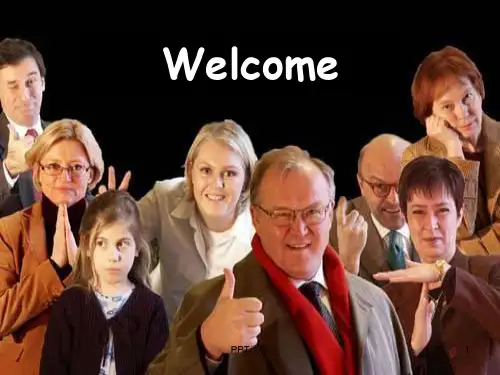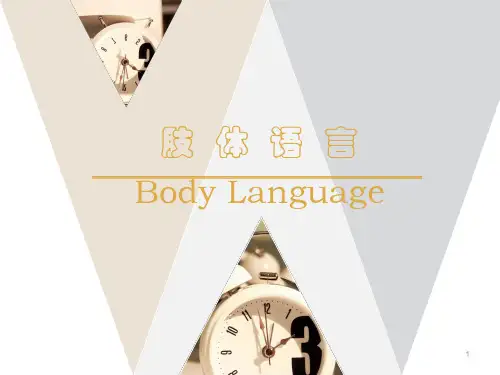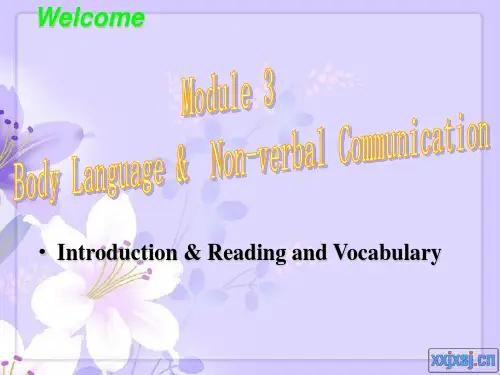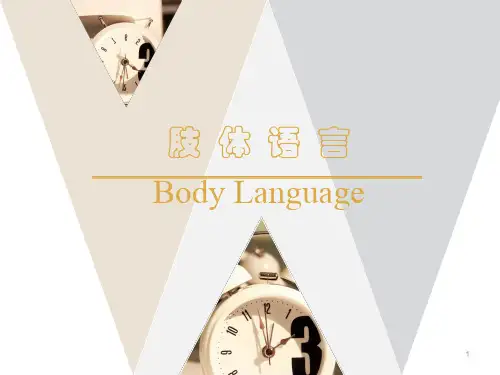英语课件:肢体语言
- 格式:ppt
- 大小:2.29 MB
- 文档页数:3











目录•Introduction to Body Language •Basic Elements of Body Language •Interpreting Body Language Signals •Cultural Variations in Body Language•Applications of Body Language KnowledgeDefinition and Importance of Body Language DefinitionBody language refers to the non-verbal communications that we use to express our feelings, thoughts, and attributes through physical behaviors such as legal expressions, eye contacts, styles, posts, and spatial relationshipsImportanceBody language plays a critical role in communication as it can convey messages that words alone cannot be It can be completed, reinforced, or even direct verbal communication, and is essential for building trust and rapport in relationshipsFunctions of Body Language in CommunicationCross Cultural Differences in Body LanguageFacial Expressions and Eye ContactFacial ExpressionsEye ContactEyebrow MovementGestures and PosturesGesturesPosturesHead MovementsVocal Elements such as Tone, Pitch, and VolumeTone01Pitch02Volume03Proxemics This refers to the use of space and distance in communication People from different cultures may have different comfort levels with personal space Standing too close to someone can make them feel uncomfortable, while standing too far away can make communication difficult要点一要点二Personal SpaceThe amount of personal space people require canvary depending on cultural norms and personal preferences In some cultures, it is acceptable to stand close to others during conversation, while in others maintaining a greater distance is preferredProxemics and Personal SpaceUnderstanding Non verbal Cues in Different ContextsNon verbal cues can indicate power dynamics between individuals, such as eye contact, pose, and spatial distancePower DynamicsBody language varies across cultures, so it's important to understand thenorms and expectations of non-verbal communication in different cultural contextsCultural Differences Body language can change depending on the social settings, so as in a business meeting, a casual conversation, or a romantic dateSocial SettingsMixed MessagesPeople may say one thing verbally but communicate something different non-verbally, so as sliming while saying something negativeIncongruence betweenverbal and non-verbalmessages can be a sign ofperception, as people mayhave diverse control overboth sidesSometimes, people's wordsand body language may notmatch due to emotionaldisconnect or internalconflictConceptDetectionEmotionalDisconnectRecognizing Incongruence between Verbal and Non Verbal Messages01 02 03Clusters of Cues MicroexpressionsBody Language and PersonalityAnalyzing Complex Body Language PatternsFarewell rituals also have buffer across cultures In some cultures, it is customary to say Goodbyeand then walk away, while in others, so as in the Middle East, it is common to say Goodbye and then stand and watch the other person leaveIn some cultures, such as in the United States, it is common to shake hands when meetingsomeone, while in other cultures, such as in Japan, a slim nod or bow is the preferred meetingThe use of Kisses on the Cheek or Hugs as greetings varies widely across cultures In some LatinAmerican countries, for example, it is common to meet someone with a kiss on the Cheek, while in many Asian cultures, this type of physical contact is many less commonGreeting and Farewell Rituals across CulturesGestures that Have Different Meanings in Different CulturesNorms for Eye Contact and Personal Space Vary by CultureImproving Interpersonal Communication SkillsUnderstanding non-verbal cuesBuilding trust and rapportManaging conflictEnhancing Public Speaking AbilitiesCommanding the stageConveying emotionManaging emotionsDeveloping Leadership Quality through Non verbal Communication。